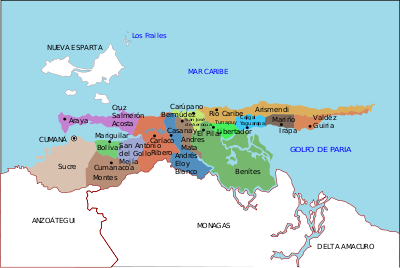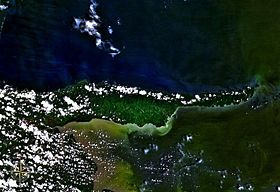
Lake Bermudez
Encyclopedia


Tar pit
A tar pit, or more accurately known as an asphalt pit or asphalt lake, is a geological occurrence where subterranean bitumen leaks to the surface, creating a large area of natural asphalt.-Known tar pits:...
and lies in Venezuela
Venezuela
Venezuela , officially called the Bolivarian Republic of Venezuela , is a tropical country on the northern coast of South America. It borders Colombia to the west, Guyana to the east, and Brazil to the south...
in northern South America
South America
South America is a continent situated in the Western Hemisphere, mostly in the Southern Hemisphere, with a relatively small portion in the Northern Hemisphere. The continent is also considered a subcontinent of the Americas. It is bordered on the west by the Pacific Ocean and on the north and east...
.
Lake Guanoco is one of the five natural asphalt lake areas in the world, the others being Tierra de Brea
Pitch Lake
The Pitch Lake is the largest natural deposit of asphalt in the world, located at La Brea in southwest Trinidad, within the Siparia Regional Corporation. The lake covers about 40 ha and is reported to be 75 m deep....
in Trinidad and Tobago
Trinidad and Tobago
Trinidad and Tobago officially the Republic of Trinidad and Tobago is an archipelagic state in the southern Caribbean, lying just off the coast of northeastern Venezuela and south of Grenada in the Lesser Antilles...
and Rancho La Brea
La Brea Tar Pits
The La Brea Tar Pits are a cluster of tar pits around which Hancock Park was formed, in the urban heart of Los Angeles. Asphaltum or tar has seeped up from the ground in this area for tens of thousands of years. The tar is often covered with water...
(Los Angeles
Los Angeles, California
Los Angeles , with a population at the 2010 United States Census of 3,792,621, is the most populous city in California, USA and the second most populous in the United States, after New York City. It has an area of , and is located in Southern California...
), McKittrick Tar Pits
McKittrick Tar Pits
The McKittrick Tar Pits are a series of natural asphalt lakes situated in the western part of Kern County in southern California. The pits are the most extensive asphalt lakes in the state...
(McKittrick
McKittrick, California
McKittrick is a census-designated place in Kern County, California, United States. McKittrick is located northwest of Taft, at an elevation of 1056 feet . The population was 115 at the 2010 census, down from 160 at the 2000 census.-Geography:...
) and Carpinteria Tar Pits
Carpinteria Tar Pits
The Carpinteria Tar Pits are a series of natural asphalt lakes situated in the southern part of Santa Barbara County in southern California....
(Carpinteria
Carpinteria, California
Carpinteria is a small oceanside city located in southeastern Santa Barbara County, California, east of Santa Barbara and northwest of Ventura. The population was 13,040 at the 2010 census, down from 14,194 at the 2000 census....
) all located in the US
United States
The United States of America is a federal constitutional republic comprising fifty states and a federal district...
state of California
California
California is a state located on the West Coast of the United States. It is by far the most populous U.S. state, and the third-largest by land area...
.
Geography
Lake Guanoco asphalt lake lies in the state of Estado SucreSucre (state)
Sucre State is one of the 23 states of Venezuela. The state capital is Cumaná. Sucre State covers a total surface area of 11,800 km² and, in 2007, had an estimated population of 916,600.-Municipalities and municipal seats:...
about 140 km (87 mi) southeast of Cumaná
Cumaná
Cumaná is the capital of Venezuela's Sucre State. It is located 402 km east of Caracas. It was the first settlement founded by Europeans in the mainland America, in 1501 by Franciscan friars, but due to successful attacks by the indigenous people, it had to be refounded several times...
close to Libertador at the Guanoco River only about 25 km (15.5 mi) east of the Golfo de Paria. The coordinates are 10°11′48"N 62°52′14"W.
The asphalt lake has a surface area of about 445 hectare
Hectare
The hectare is a metric unit of area defined as 10,000 square metres , and primarily used in the measurement of land. In 1795, when the metric system was introduced, the are was defined as being 100 square metres and the hectare was thus 100 ares or 1/100 km2...
(1 100 acres) and the depth varies between 1,5 to 2 meters (3 to 10 feet) with an estimated volume of about 6 million tons.
Even though Lake Guanoco is larger in area as the Tierra de Brea in Trinidad it is smaller in volume, but its tar is purer than Tierra de Brea.
Lake Guanoco is also different to other asphalt lakes as it is covered in vegetation.
Geology
All asphalt lakes were probably created during the PleistocenePleistocene
The Pleistocene is the epoch from 2,588,000 to 11,700 years BP that spans the world's recent period of repeated glaciations. The name pleistocene is derived from the Greek and ....
epoch
Epoch (geology)
An epoch is a subdivision of the geologic timescale based on rock layering. In order, the higher subdivisions are periods, eras and eons. We are currently living in the Holocene epoch...
and share the same geological principal.
The creation of an asphalt lake is related to deep faults
Geologic fault
In geology, a fault is a planar fracture or discontinuity in a volume of rock, across which there has been significant displacement along the fractures as a result of earth movement. Large faults within the Earth's crust result from the action of tectonic forces...
between two tectonic plates
Tectonic Plates
Tectonic Plates is a 1992 independent Canadian film directed by Peter Mettler. Mettler also wrote the screenplay based on the play by Robert Lepage. The film stars Marie Gignac, Céline Bonnier and Robert Lepage.-Plot summary:...
. In connection with subduction
Subduction
In geology, subduction is the process that takes place at convergent boundaries by which one tectonic plate moves under another tectonic plate, sinking into the Earth's mantle, as the plates converge. These 3D regions of mantle downwellings are known as "Subduction Zones"...
pressure is created against underlying oil source rock
Source rock
In petroleum geology, source rock refers to rocks from which hydrocarbons have been generated or are capable of being generated. They form one of the necessary elements of a working petroleum system. They are organic-rich sediments that may have been deposited in a variety of environments including...
.
The oil is moving towards the surface and slowly transforming into bitumen and on the way through the lithosphere
Lithosphere
The lithosphere is the rigid outermost shell of a rocky planet. On Earth, it comprises the crust and the portion of the upper mantle that behaves elastically on time scales of thousands of years or greater.- Earth's lithosphere :...
it’s picking up clay and water and is cooled into asphalt.
History
It is unknown when Lake Guanoco was discovered, it has been known for a long time by the Warao people who used the asphalt for their canoes.In 1799 German Explorer Alexander von Humboldt
Alexander von Humboldt
Friedrich Wilhelm Heinrich Alexander Freiherr von Humboldt was a German naturalist and explorer, and the younger brother of the Prussian minister, philosopher and linguist Wilhelm von Humboldt...
described the site during his Latin American expedition as "The source of the good priest" (Quelle des guten Priesters).
In 1883 the government of Venezuela signed a contract with Americans Horacio R. Hamilton and Jorge A. Phillips who received concessions for 25 years to mine asphalt This concession caused some debate as the profits went to foreign companies.
In 1890 the mining started by the "New York & Bermúdez Company". In 1899 the government under Cipriano Castro
Cipriano Castro
José Cipriano Castro Ruiz was a high ranking member of the Venezuelan military, politician and the President of Venezuela from 1899 to 1908...
put higher taxes on the company, in response the company supported the opposing side under Manuel Antonio Matos. The conflict escalated and culminated in 1901 in the "Asphalt War / Venezuelan conflict". The conflict even led to a temporary interruption in the diplomatic relations between the USA and Venezuela between June and December 1908.
In 1934 the commercial mining of the asphalt stopped and has not been re-establish since.

